Cool and relatively dry
- Overall (using provisional data from the Island of Ireland dataset*), July 2024 had an average temperature of 14.77 °C, which is 0.59°C below the 1981-2010 long term average (LTA), 0.61 °C below the 1991-2020 LTA and 0.08 °C below the 1961-1990 LTA for July.
- July 2024 was the 61st coldest July in the 125 year dataset and the coldest since July 2020. July 2013 was the warmest July on record with an average temperature of 17.34 °C and July 1922 was the coldest July with an average temperature of 12.68 °C.
- Provisional gridded rainfall data for Ireland suggests July 2024 saw 78% (65.1 mm) of its 1981-2010 LTA rainfall. July 2023 was the wettest July on record with 225% (187.0 mm) of its 1981-2010 LTA rainfall.
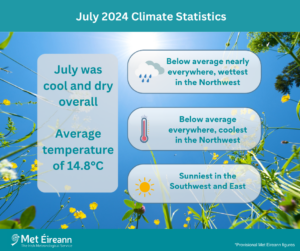
July 2024 Climate Statistics
July 2024 saw Ireland situated on the cooler northern side of the jet stream for most of the month. It was cool overall, relatively dry and quite dull at times. The first third of the month was particularly cool with persistent low pressure to the north and northeast feeding in a Polar maritime airmass over the country in a westerly or north-westerly airflow. This brought frontal rain or showers at times interspersed with drier periods. Low pressure moved up from the south on Tuesday 9th bringing a period of heavier rain to the South and East of the country. The second third of the month was drier especially in the South and East. High pressure, initially to the west, moved in over the country for a few days before pulling away to the north. It got a little milder during this period but stayed relatively dull. High pressure built to the south on the 16th but quickly pulled away to the east, allowing bands of frontal rain, associated with Atlantic low pressure systems, to encroach from the west. Several frontal rain bands crossed the country from the west between Wednesday 17th and Monday 22nd, with the bulk of the rain falling in the western half of the country. The remaining third of the month was mixed, with low pressure to the north in control initially, bringing bands of rain or showers, before high pressure to the south gradually built north, bringing a drier and warmer finish to the month with more sunshine.
Rainfall: Below average almost everywhere, wettest in the Northwest
Nearly all rainfall totals were below their 1981-2010 Long-Term Average (LTA) for the month. Percentage of monthly rainfall values ranged from 50% (monthly rainfall total of 38.8 mm) at Sherkin Island, Co Cork to 102% at both Belmullet, Co Mayo (monthly rainfall total of 80.6 mm) and Knock Airport, Co Mayo (monthly rainfall total of 97.3 mm). Monthly rainfall totals ranged from 37.9 mm (67% of its LTA) at Dublin Airport, Co Dublin to 97.3 mm at Knock Airport, Co Mayo (102% of its LTA). The highest daily rainfall total was 16.6 mm at Johnstown Castle, Co Wexford on Tuesday 9th. The number of rain days* ranged from 15 days at both Roche’s Point, Co Cork and Johnstown Castle, Co Wexford to 24 days at Knock Airport, Co Mayo. The number of wet days* ranged from 10 days at Roche’s Point, Co Cork to 18 days at Knock Airport, Co Mayo. The number of very wet days* ranged from zero days at a few stations to 4 days at Knock Airport, Co Mayo.
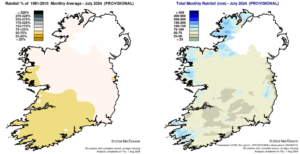
Rainfall % of 1981 – 2010 Monthly Average for July 2024 (Provisional) Total Monthly Rainfall (mm) for July 2024 (Provisional)
Temperature: Below average everywhere, coolest in the Northwest
All station mean air temperatures across the country were below their LTA for the month. Deviations from mean air temperature ranged from -1.1 °C (14.0 °C mean temperature) at Markree, Co Sligo to -0.2 °C (15.3 °C mean temperature) at Phoenix Park, Co Dublin. Mean temperatures for the month ranged from 13.4 °C (0.5 °C below its LTA) at Knock Airport, Co Mayo to 15.3 °C at both Shannon Airport, Co Clare (0.9 °C below its LTA) and Phoenix Park, Co Dublin (0.2 °C below its LTA). The month’s highest temperature was reported at Moore Park, Co Cork on Wednesday 31st with a temperature of 24.1 °C. The month’s lowest air temperature was recorded on Monday 8th at Mount Dillon, Co Roscommon with 4.7 °C while the lowest grass minimum was -0.1 °C reported at Mullingar, Co Westmeath on Friday 5th. There was no air frost reported this month. One station, Mullingar, Co Westmeath, reported ground frost this month, on Friday 5th. Five stations had their coldest July since 2015 and twelve stations had their lowest mean minimum for July since 2015.
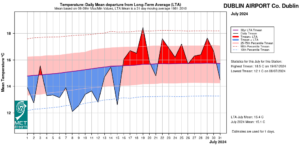
Dublin Airport, Co Dublin Temperature: Daily mean departure from LTA for July 2024 based on 09-09hr Max/Min values.
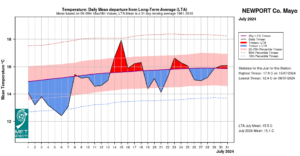
Newport, Co Mayo Temperature: Daily mean departure from LTA for July 2024 based on 09-09hr Max/Min values.
Sunshine: Sunniest in the East and Southwest
Percentage of LTA sunshine values were variable across the country. Percentage of monthly sunshine values ranged from 99% (the highest monthly sunshine total of 151.5 hours) at Casement Aerodrome, Co Dublin to 100% (monthly sunshine total of 139.6 hours) at Shannon Airport, Co Clare. Monthly sunshine totals were lowest at Gurteen, Co Tipperary with 116.4 hours (No LTA comparison*). The highest number of daily sunshine hours recorded this month was 15.3 hours at Dublin Airport, Co Dublin on Monday 8th. The number of dull days* ranged from 3 days at Gurteen, Co Tipperary to 7 days at Dublin Airport.
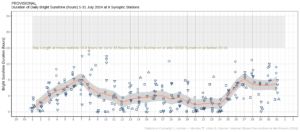
Hours of Bright Sunshine observed at nine stations for each day of the month of July 2024, grouped by province relative to the highest number of hours possible by end of month (shaded box)
Wind: Not significantly strong
Monthly mean wind speeds ranged from 4.6 knots (8.5 km/h) at Ballyhaise, Co Cavan to 11.8 knots (21.9 km/h) at Mace Head, Co Galway. There were no days with gales, strong gales or storms reported this month. The month’s highest gust was reported at Finner, Co Donegal on Wednesday 3rd with 46 knots (85 km/h). The month’s highest 10-minute mean wind speed was 32 knots (59 km/h) at Malin Head, Co Donegal on Thursday 4th.
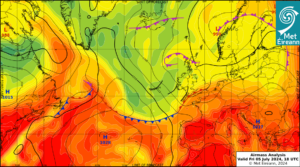
Airmass Analysis chart 18 UTC 5 July 2024: Ireland lies in a cool Polar maritime airmass with a north-westerly airflow.
The full report is available at https://www.met.ie/climate/past-weather-statements

Extreme values for July 2024 at synoptic stations
*Issued by Met Éireann on Friday 2nd August 2024. This report is based on available preliminary data from 25 principal weather stations operated by Met Éireann. Synoptic station data is midnight to midnight UTC. Long-Term Averages (LTAs) and “average” refer to the period 1981-2010 unless stated. A rain day is a day on which 0.2 mm or more of rainfall is measured. A wet day is a day with 1.0 mm or more of rainfall. A dull day is a day with less than 0.5 hours of sunshine. A very wet day is a day with 10.0 mm or more of rainfall. Climatological dry periods – An absolute drought is a period of 15 or more consecutive days to none of which is credited 0.2 mm or more of precipitation. A partial drought is a period of at least 29 consecutive days, the mean daily rainfall of which does not exceed 0.2 mm. A dry spell is a period of 15 or more consecutive days to none of which is credited 1.0 mm or more of precipitation (i.e. daily tot < 1.0 mm). A heatwave occurs where there are 5 consecutive days or more with maximum temperature over 25°C (that is, a daily maximum screen air temperature > 25° C). The Island of Ireland dataset is 125 years long and runs between 1900 and 2023. For this dataset the long term averages from the 1961-1990 reference period are used for comparison as is standard for long-term climate change assessments. *Sunshine data is from the Autosol Network. LTAs for these sites are currently not used for comparison purposes. For more information, contact Met Éireann at 01-8064200 or e-mail: enq@met.ie